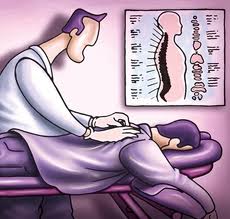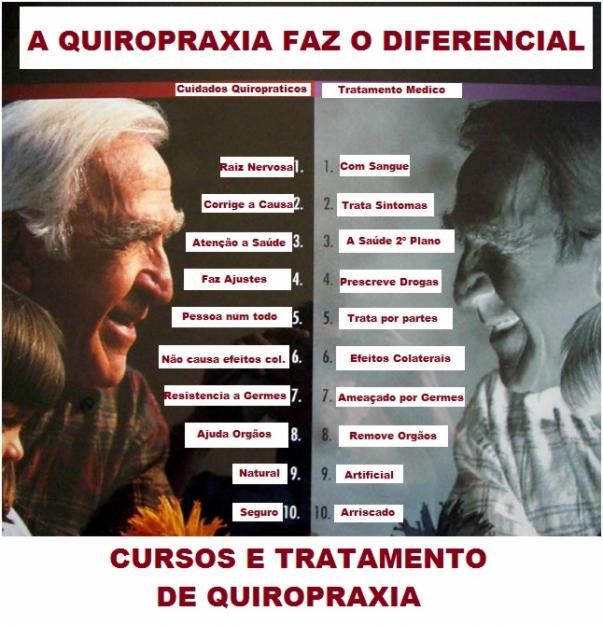Quiropraxia
Quiropraxia
Quem deve procurar um Quiropraxista?
As principais condições tratadas com Quiropaxia são: Dor nas costas, dor lombar, dor torácica, dor cervical, dor de cabeça, cefaléia, enxaqueca, lombalgia, cervicalgia, hérnia de disco, bursite, torcicolo, tendinite, dor no joelho, dor no ombro, dor no tornozelo, dor no cotovelo, dor no punho, sindrome do túnel do carpo, zumbido, dores e tensão muscular, dores articulares, restrições a movimentação, insônia e até depressão. Estes e outros problemas são avisos do corpo de que algo não está bem. Na Quiropraxia está o seu alívio.
Ligue e agende um horário.
Quiropraxista - Jayldo
Contatos:
(011) 5741-3171
(011) 8406-1489
Jayldomelo@yahoo.com.br

Definition
Chiropractic is a health profession concerned with the diagnosis, treatment and prevention of disorders of the musculoskeletal system, and the effects of these disorders on the nervous system and general health. There is an emphasis on manual treatments, including spinal manipulation.
The word chiropractic, from the Greek words praxis and cheir, means practice or treatment by hand. Like the word pharmaceutical it is used both as an adjective (e.g. chiropractic profession) and as a noun (e.g. as in the title and definition above).
Origin and Professional Organization
The profession was founded in the U.S. in 1895 and is now established in over 70 countries. National associations of chiropractors from these countries are members of a World Federation of Chiropractic, based in Toronto, Canada, which is in official relations with the World Health Organization. There are approximately 65,000 doctors of chiropractic in the U.S., 6,000 in Canada and 90,000 internationally.
Education and Licensure
In North America there is a minimum of six years full time university-level education, which includes two years of university credits in qualifying subjects and then a four year undergraduate program at chiropractic college. This is followed by national and state/provincial licensing board examinations. Postgraduate specialties include chiropractic sciences, neurology, nutrition, orthopedics, radiology, rehabilitation and sports chiropractic.
Internationally, common standards of education have been achieved through a network of accrediting agencies that began with the U.S. Council on Chiropractic Education (CCE), recognized by the U.S. Office of Education since 1974. There are chiropractic colleges in Australia (3), Brazil (2), Canada (2), Denmark, France, Italy, Japan (2), Korea, New Zealand, Mexico, South Africa (2), Spain, Sweden, Switzerland, the United Kingdom (4) and the United States (16). In most countries these colleges are now in the public university system.
Licensing Laws
The practice of chiropractic is now recognized and regulated by law in many countries in all world regions. Common features of all licensing laws are primary care (i.e. the right of a patient to consult a chiropractor directly), and the right and duty to perform a diagnosis. Diagnosis includes the right to use x-ray and other diagnostic imaging and tests.
Title
The professional titles most commonly approved by law in the U.S. states and Canadian provinces are chiropractor and doctor of chiropractic. Many U.S. states also approve the title chiropractic physician. In these states the title physician is given to chiropractic, medical and osteopathic doctors in recognition of their competence and duty to perform a diagnosis.
Practice
The chiropractic profession emphasizes the natural power of the body to heal itself (homeostasis) and therefore chiropractic practice does not include the use of drugs or surgery. Patients requiring these interventions are referred for medical care. Chiropractors use natural or non-invasive treatment approaches including manual treatments, physical therapy modalities, exercise programs, nutritional advice, orthotics, lifestyle modification and other patient education. There is an emphasis on joint manipulation, for which the traditional chiropractic term is joint adjustment, because of its proven effectiveness.
Surveys in Australia, Europe and North America report that approximately 95% of chiropractic patients have musculoskeletal pain conditions (e.g. back pain, neck pain, headache, pain in the shoulder, arms or legs) as their main complaint. Research and research-based practice guidelines from various multidisciplinary expert panels in the 1990s have endorsed chiropractic management by recommending spinal manipulation, over-the-counter pain medication, exercise and early return to activities as the most effective and cost-effective management for most patients with back pain, neck pain and tension-type headache.
The other 5% of chiropractic practice involves patients with a wide variety of conditions that are caused, aggravated or mimicked by restricted range of movement in the spinal vertebrae and muscles, termed spinal dysfunction or subluxation, and the pain and other reflex effects of this expressed through the nervous system. Such conditions include dysmenorrhea, asthma and other respiratory dysfunctions, colic, constipation and other digestive dysfunctions.
For various reasons, including improved chiropractic education and research during the past 20 years and the expectations-indeed the demands-of patients, much of the former conflict between the chiropractic and medical professions has been replaced by mutual respect and cooperation. Interdisciplinary practice is now common, with chiropractic and medical doctors, physical therapists and others working as partners or referring patients as necessary in general practice, occupational health, automobile accident and other rehabilitation centers and sports medicine teams.The Chiropractic Profession
by David Chapman-Smith

